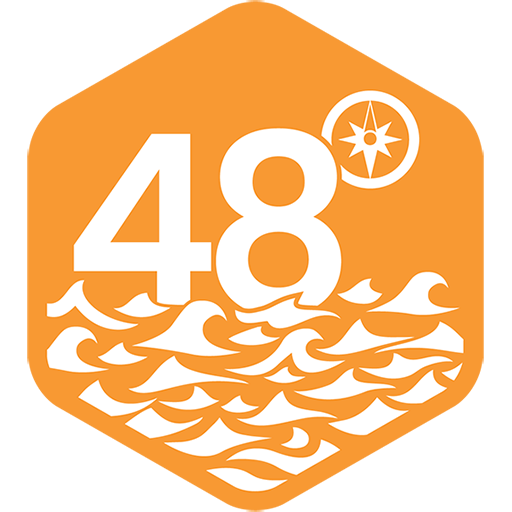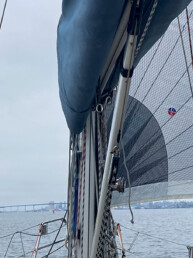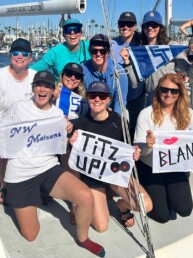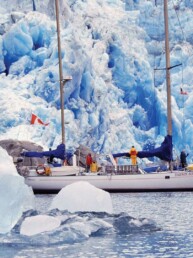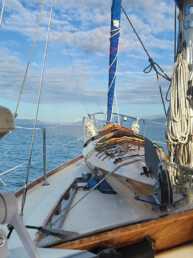Heady boat nerds will be familiar with the philosophical paradox known as “The Ship of Theseus.” Originally recorded by the Greek Philosopher, Plutarch, this famous thought experiment poses the question of whether something remains what it is even after all of its original components have been replaced. For those who understand boats, wooden boats especially, it’s never very far from reality. Any wooden boat with a long life will have every plank, frame, knee, and breasthook replaced, even its keel will eventually need to be renewed. The fact that I personally come down on the side that views the mythical Theseus’s ship as itself even after a complete replacement is moot in this article, however. This story starts with a different, though not unrelated question: What of those discarded materials that were formerly part of the ship?
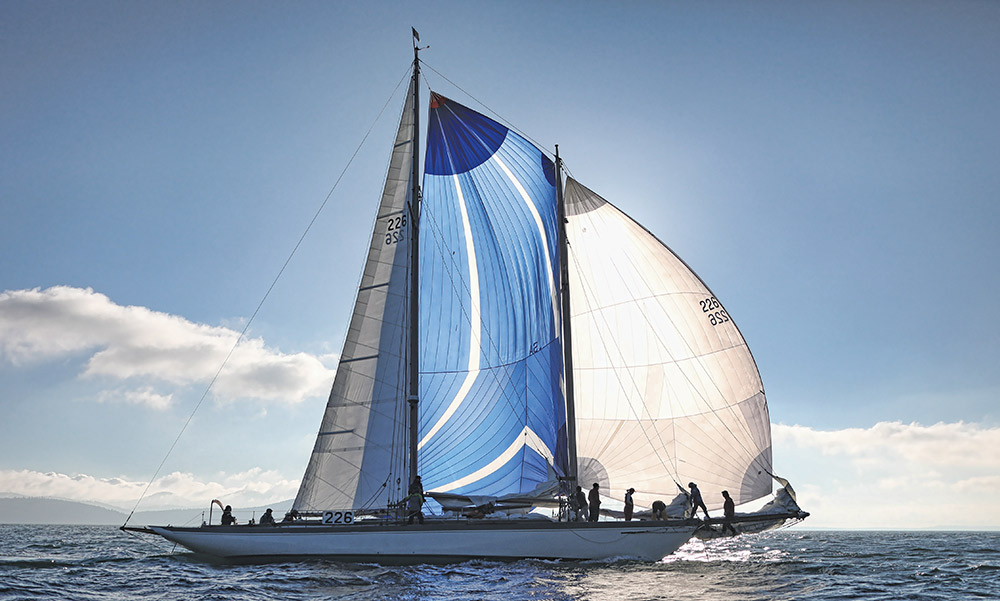
If this isn’t the coolest example of what might be done with discarded material, I don’t know what is. Let me set the hook—a new boat is born, constructed of old-growth wood milled from the massive log of Western Red Cedar that was harvested near Washington’s Hoh Rainforest and spent the last 115 years as the main mast for the storied Schooner Martha. The new boat was built by maritime students spanning generations and backgrounds, different groups and programs were hands-on at every stage of construction. This immense piece of timber spent nearly half of its history as a mast on a boat being used primarily for sail training; it facilitated countless hours of tangible maritime training in its next employment as building material; and now it sails again as a part of the fleet of the non-profit committed to education, adventure, and connection to the sea. This tree is a teacher.
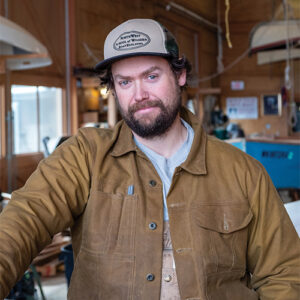
A few years ago, the Schooner Martha Foundation set out to repair a substantial check in the vessel’s main mast. Assessing its condition, the foundation altered course and approached Northwest Maritime’s (NWM) Boat Shop Manager, Joel Arrington, about using the Port Townsend campus’s Boat Shop space to construct a replacement. Arrington recalls, “Working non-profit to non-profit, I said I’ll donate the space but told them there was a condition—you have that 80-foot stick of Western Red Cedar, it’s got a cool story, I’d love to build a boat out of it.”
Arrington’s inspiration began with the wood itself. He reached out to a dendrologist at the University of Washington, who helped fill in some details. Based on information about the majority of the logging at the time Martha was constructed and the locations of secondary growth forests, in addition to some specifics about where the yard that built the schooner sourced their materials, it is clear that the tree would have come from the area around the Olympic Peninsula’s Hoh Rainforest. The tree was likely harvested around the turn of the century, then it was barged down to San Francisco where Schooner Martha was launched in 1906.
Arrington had never milled a piece of lumber like this before. “It’s not often you get an 80-foot log of old growth Western Red Cedar. The fun part is that I had this enamored idea that it would be this beautiful old growth log that was so perfect, like what everybody thinks of being cut down 130 years ago. It was straight, but not especially high quality—it was super knotty and had some old checks and repairs.”
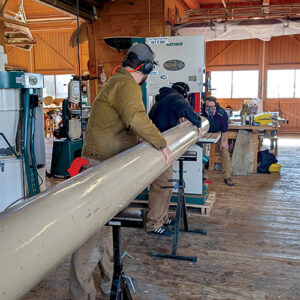
A graduate of the Northwest School of Wooden Boatbuilding, Arrington clarified, “Red Cedar is not considered a spar-worthy material—nobody would build a spar out of it now except maybe for a little dinghy or something—and the boat sailed for 115 years under that mast with no major issues.” As other sailors in the area can certainly attest with multiple Transpac races and an array of other intensive ways Martha is used, Arrington summed it up, “They sail the piss out of that boat, and it held up.”
Part of the vision for this former mast was an opportunity to host a 10-day strip building construction workshop for adult students—strip building is a technique for which Western Red Cedar is an ideal material. He guided students through how to develop and build a strongback, layout all the frames, and plank the boat with strips of the century-old cedar. The students helped with some of the milling as well, cutting the bead and cove joinery on each strip. While there is an exceptional amount of prep work, when it actually came time to plank the boat, the class completed that phase of the project in a single long day, showing the efficiency of this type of construction. It took another six days to fair and sand the boat, add the skeg shoe and outer stem, and laminate the exterior of the hull in fiberglass, remove the boat from the molds and repeat the process on the interior before building out floor timbers, thwarts, seats, and the gunwale assembly. By the end of the class, they had built a boat that was structurally sound enough to go into the water, and the new boat had a “soft” launch and test run of rowing around the harbor at the Wooden Boat Festival in 2022.
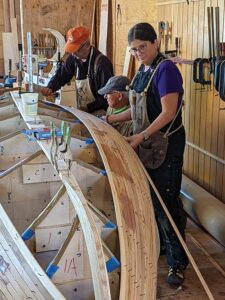
The design of the boat is an adaptation of the Sid Skiff, drawn by Ray Speck of San Francisco. Speck is a legend in the West Coast wooden boat community, and has built Sid Skiffs in production. Speck donated the plans to NWM for this project. Of the Sid Skiff, Arrington said, “They’re traditionally built clinker, and one of the cool things about this boat is that it’s a more modernized construction, we shaved off probably around 200-pounds from the finished product.”
All up, the new boat weighs only about 95 pounds; and the clinker-built Sid Skiff that sits outside the Boat Shop window weighs 300 pounds and includes 1,400 fasteners. The new boat’s hull thickness with laminations is ⅜ of an inch, which would be at least a quarter-inch less material than a traditionally built version. With a number of modifications away from the original 13-foot Sid Skiff design, the NWM Boat Shop crew began calling the boat the “Grizzly Skiff” through the build process as a way to delineate its differences from the original design (after being thrilled with an extensive sponsorship that included $50,000 in new tools to outfit the shop from the Bellingham-based power tool manufacturer, details in sidebar). The Grizzly Skiff is now called Ruby, named after the Olympic Peninsula’s Ruby Beach near the origin of the fabled tree.
The modifications from the original extend beyond construction. The Grizzly Skiff switched from the Sid Skiff’s traditional centerboard to a daggerboard, for simplicity and better sailing performance. It’s a true foil and was calculated and cut on the CNC by Brandon at Port Townsend’s Turn Point Design. The entire fit-out, thwarts, sheets, internal structures, rudder, daggerboard were all made of off-cuts from the remarkably high-quality aircraft grade Sitka Spruce harvested on Vancouver Island and chosen for Schooner Martha’s new mast (which interestingly utilizes elliptical box construction for extraordinary stiffness).
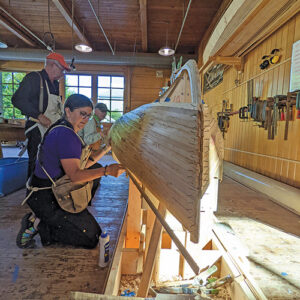
The lumber for Ruby’s loose-footed sprit rig also came from Martha’s mast, but incidentally it’s not Western Red Cedar. Martha was originally gaff rigged, but in the 1970s it was refitted with a Marconi rig, at which time 27 feet were added to the mast. This additional length was Alaskan Yellow Cedar, clothes-pinned on to the top of the solid Western Red Cedar mast. So, Ruby’s sprit and the mast are made from that Alaskan Yellow Cedar that was on the top of Martha’s retired mast for last 50 years.
The original strip planking workship dovetailed into numerous follow-on educational opportunities in NWM’s Boat Shop, not to mention layers upon layers of community engagement. Arrington estimates there were at least 100 hours of work required to complete the boat after it was built, and he’s paid to facilitate learning, not build boats himself. Volunteers were involved. High school students were involved. Nick Mann of Whalesong Signs worked with an apprentice from NWM’s High School Maritime Career Immersement (MCI) program to teach the lovely traditional gold leaf detailing and boat lettering found on Ruby’s hull and transom—notably, this student apprentice has since moved onto further study at Port Townsend Maritime Academy.
It’s clear that one of the values of Arrington’s deep knowledge is his ability to be creative with curriculum, helping students build useful maritime skills by adapting to the present needs of whatever project is underway at the time. Students cycling through the NWM programs had their hands on the Grizzly Skiff in each phase of the build. MCI students got a particularly great exercise in boat joinery when they built out the sole boards. “How do you make things fit into something that’s not square and build strength in the boat?” They learned to make tab patterns, build the daggerboard compartment, and develop the basics of marine finish. Arrington noted, “A student off-ramping into work at a boatyard will have a taste of those skill sets now.”
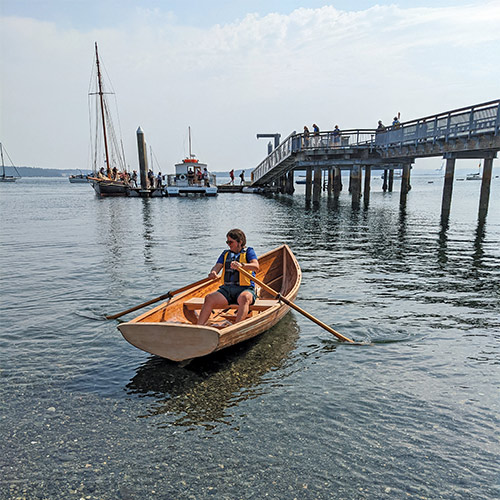
At the time of this writing, the Northwest School of Wooden Boatbuilding is teaching a week-long sailmaking class, and the end product will be a beautiful, custom built new sail for this boat. Like almost all boat builds, the Grizzly Skiff has been a shared passion project that has brought more people together than anyone might have guessed. And they’re better for it.
With its elegant lines and light weight, the boat rows incredibly well. And its sailing performance has also impressed everyone who has caught a little wind in Ruby’s loose-footed sprit sail, with the exquisitely honed deep daggerboard delivering grins at almost any angle of heel.
Looking back on the project, Arrington is satisfied with so many aspects. He didn’t use the word, but I think he’s proud as well. He mentioned several times how important it felt to him to “take a traditional model and utilize contemporary techniques.” He says of this approach, “It’s a good way to instill more transferable skills—we love to celebrate old wooden boats, but teaching contemporary techniques is more transferable to a career path.”

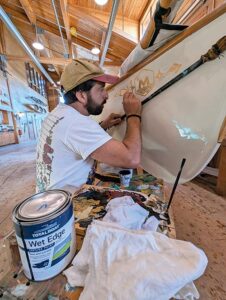
But what’s most special about this project is all of its unique local connections. Western Red Cedar trees have been known to live at least 1,500 years. And while this tree’s exact age is not known, it was of our region, and had an actual life that makes Schooner Martha’s extensive history seem fairly brief. Once harvested and employed as a main mast, it enabled innumerable adventures and was the centerpiece of the sailing rig that started and trained many, many stalwarts in the PNW maritime scene, from lifelong enthusiasts to industry professionals. And in this project alone, countless community ties were made or strengthened between those of varying skills, backgrounds, and aspirations in the world of boats.
For Arrington, it circles back to what respect—even love—for the timber can teach maritime students. “It’s good practice in recycling materials. We don’t have a lot of these old growth trees left, and the modern techniques are a better use of the old chunks because they have less waste than the traditional.”
This fine tree will now live on as Ruby the Grizzly Skiff and, with its place at Northwest Maritime, it is inevitable that this Olympic Peninsula Western Red Cedar will continue its generous teaching tradition—as a mast on a sail training schooner and as material for betterment and skill building of maritime students—by showing the next generation what some awesome ancient wood can do on the water.
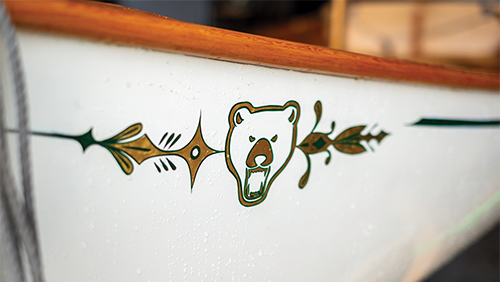
Powered By Grizzly
When Bellingham’s Grizzly Industrial Tools sponsored the Northwest Maritime Boat Shop with a donation of $50,000 worth of new tools—from huge band-saws to hand-held power tools and a state-of-the-art air filtration system—no one knew exactly what the impact would be. Everyone just knew it was big. A year into the relationship, Boat Shop Manager Joel Arrington says one major benefit is the ingenuity and flexibility enabled by a complete set of reliable, predictable, equally-functional tools. “The Grizzly tools make more projects like the Grizzly Skiff possible,” Arrington enthused.
Joe Cline has been the Managing Editor of 48° North since 2014. Thanks to the many photographers whose images appear in this story, including Joel Arrington, Sam Trocano, as well as those named and the author.
Joe Cline
Joe Cline has been the Managing Editor of 48° North since 2014. From his career to his volunteer leadership in the marine industry, from racing sailboats large and small to his discovery of Pacific Northwest cruising —Joe is as sail-smitten as they come. Joe and his wife, Kaylin, have welcomed a couple of beautiful kiddos in the last few years, and he is enjoying fatherhood while still finding time to make a little music and even occasionally go sailing.
